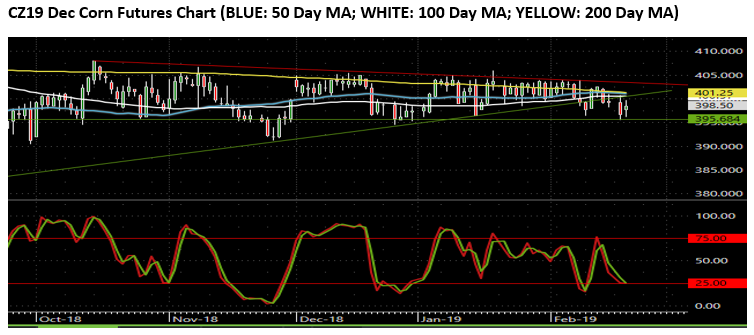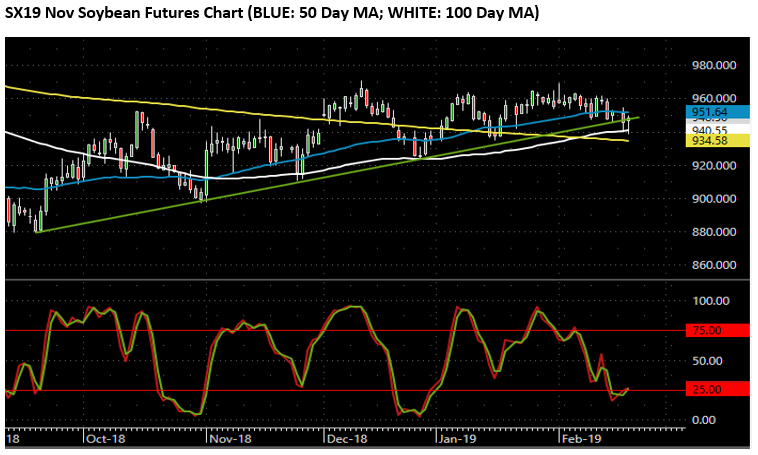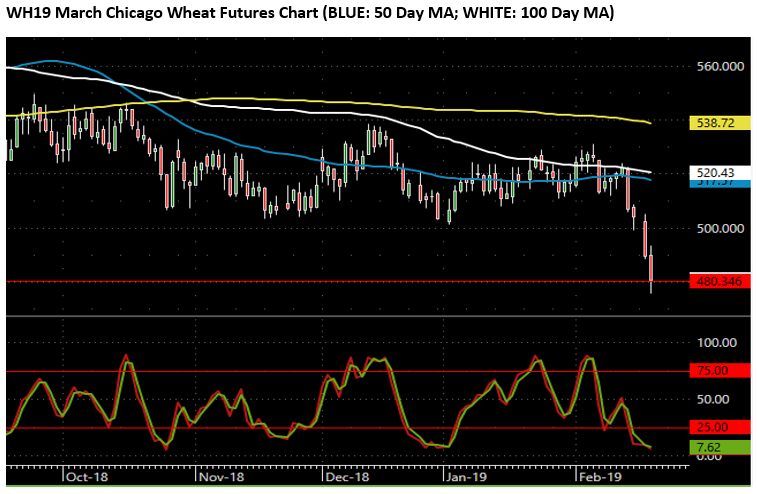Special Market Update
Grain Market Commentary
Wednesday, February 20, 2019
By Rhett Montgomery, Grain Associate, The Andersons
Corn:
March corn futures (CH19) finished the day up a penny, closing at $3.7075. For the month of February, the March corn contract is down 5.75c as the market continues the range-bound trade that has been the feature since last fall. The feeling was that the first USDA report in over a month on the 8th would help to give the market some direction moving forward, and while the report was slightly bullish, cuts to the demand side in feed and ethanol use offset some of the supply side reductions. Ethanol margins continue to be extremely thin and plants going idle or reducing grind capacity will continue to be an issue going forward, especially if we are to see a spring/early summer rally in futures.
As we enter spring, corn seems to have the most compelling story of the three commodities discussed here. Fundamentally, the market looks very susceptible to a rally with the stocks/use ratio the tightest it has been since 2013/14 at 11.7%. China-U.S. trade talks continue this week, and it is expected that President Trump and Chinese President Xi Jinping will meet next month and lately there is more optimism regarding the two parties reaching an agreement sooner rather than later. Any agreement seems likely to include China purchases of corn and ethanol from the U.S., this combined with any planting weather issue could light a fire under the corn market. From where I am at in Nebraska, January and February had a very high amount of foggy days, and if the old folk tale is true this would mean a wet spring and the possibility of planting delays could lead to some weather premium in the market.
In terms of technical indicators and using the December corn (CZ19) chart below, the market is approaching key support points in the $3.90 to $3.95 range. However, in the past three sessions the market has broken through trendline support that had held for the past 3-4 months, it will be interested in the coming days how much resistance the $4.00 mark will cause after serving as very strong support for the previous several weeks. The market is entering moderately oversold conditions and a move upward towards the $4.00 level seems likely in the short term. Over the longer term, looking at the moving averages, the 50 and 200 day averages (blue and yellow lines respectively) have converged, and a break of the 50 day MA above the 200 day is considered a strong bullish indicator. For those looking to hedge new crop 2019 bushels it will be important to keep an eye on this market in the next few months. I am personally eyeing the $4.36 mark as a potential high for the December board given the fundamental and technical situation, and it is a good idea to have orders in ahead of this market to capture some opportunities that have the potential to become realities this spring/early summer.

Soybeans:
March soybeans (SH19) finished Wednesday’s session up 1.75c, closing at $9.0250. For the month of February, March futures are down 18.5c. The market overcame weakness early in the session but late optimistic headlines combined with a hold above the psychological $9.00 level pulled the market up on the day.
When discussing the soybean market, it is very hard to not sound like a broken record: oversupplied, record ending stocks, headline driven trade, etc. Since the February 8th USDA report, it does seem that even with the cuts in U.S. and South American production and ending stocks, the market was reminded of ending stocks north of 900 million bushels and it appears is beginning to price in that reality. This weakness comes despite a January record for soybean crush in the U.S., further indicating how bearish the supply situation is, both in the U.S. and world balance sheets. The trade will undoubtedly be watching how China-U.S. trade talks progress to end this week and looking forward to next month’s meetings. However, it appears that any agreement made at this point will be more for the benefit of upcoming crop year demand as Brazil is now over 1/3 harvested and will now become a huge player in the world export market again.
Technically, the market yesterday broke below trendline support which had held since early fall. The next few sessions will be key as should the market fail to pullback above the trendline, or fail at the 100 and 200 day MAs (white line and yellow line respectively on chart), the next downside target will be $9.20 followed by $9.10. The soybean market has also entered moderately oversold conditions. Look for the soybean market to continue its choppy trade driven by daily trade headlines in the short term. In the long term, there is a lot of room to the downside if we get a surprisingly large planting intentions number at the end of March.

Wheat:
March Chicago wheat (WH19) closed at $4.80 today down 9c. The Kansas City Hard Red Winter Wheat contract closed at $4.50, down 10.75c. For the month of February, Chicago wheat is down 35c, while KC is down 50c.
This week has marked large losses for wheat as the board has dropped upwards of 30c in the past four sessions. This weakness is due largely to the U.S. continuing to be uncompetitive with other nations for export business, especially as French wheat futures have plunged leaving them the cheapest option in the world. This weakness comes despite cuts in world ending stocks. U.S. ending stocks were raised in the Feb. 8th USDA report, primarily due to lower domestic use. With exports now running quite a bit behind last year’s pace and the USDA still forecasting a year over year increase of 100 million bushels, it will be interesting to see how the USDA adjusts the wheat export estimate in future reports.
Winter wheat plantings in the U.S. are said to be a 100+ year low at 31 million acres. Nebraska planted acres are a record low. There was some concern over winterkill in the Nebraska-Kansas region but the recent snow coverage should alleviate some of those concerns. It will be interesting to see how the low plantings in the U.S. coupled with steady to rising world demand for wheat will affect the balance sheet for the 2019/2020 marketing year.
Technically, the market is oversold, and it would not be surprising to see a technical correction within the next few sessions after four heavy down days. The March board today (WH19) today traded down to levels not seen since December of 2017. This will most likely serve as support moving forward, and it helps that the close today close to a round number of $4.80 can serve as a psychological support line, should the market break below this level there is most likely a lot of air beneath. Overall, I look for the market to stabilize in the short term before looking towards winter wheat growing season/harvest weather for possible premiums to price in.
